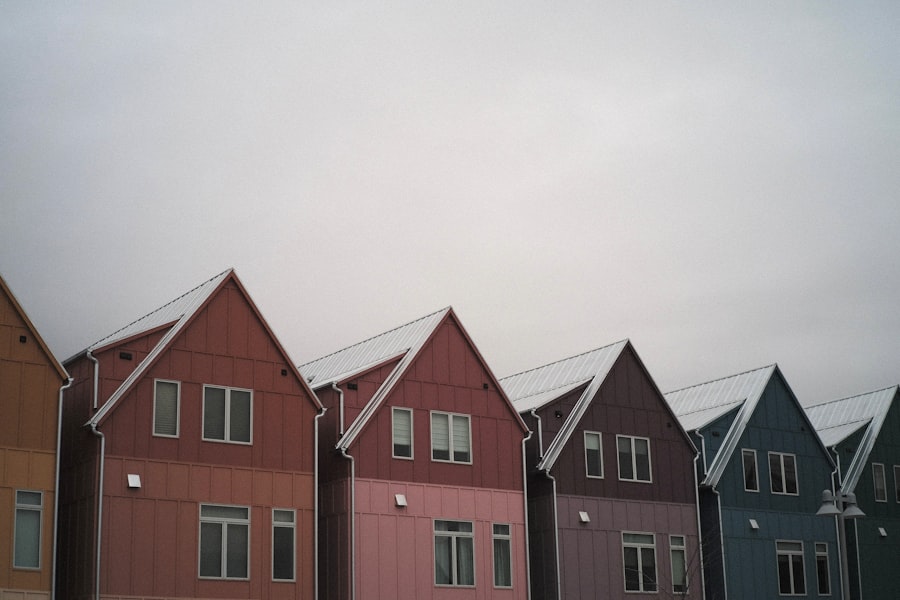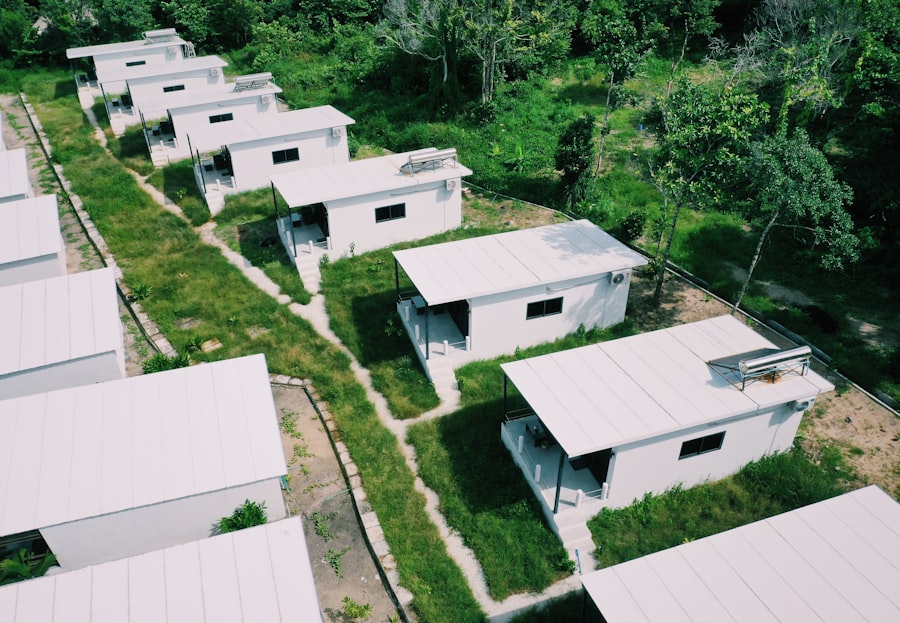In recent years, the housing market has witnessed a significant transformation, with modern prefabricated homes emerging as a popular alternative to traditional construction methods. This shift can be attributed to various factors, including advancements in technology, changing consumer preferences, and a growing awareness of environmental sustainability. Prefabricated homes, often referred to as “prefabs,” are constructed off-site in controlled environments and then transported to their final locations for assembly.
This method not only streamlines the building process but also allows for greater precision and quality control. The resurgence of interest in prefabricated homes can also be linked to the increasing demand for affordable housing solutions. As urban populations swell and housing prices soar, many individuals and families are seeking innovative ways to secure their own living spaces without incurring crippling debt.
Prefabricated homes offer a viable solution, providing a range of options that cater to diverse budgets and lifestyles. Furthermore, the stigma that once surrounded prefabs—often associated with low-quality materials and temporary structures—has dissipated as manufacturers have embraced modern design principles and sustainable practices.
Key Takeaways
- Modern prefabricated homes are on the rise due to their efficiency and cost-effectiveness.
- Prefabricated homes offer benefits such as faster construction, reduced waste, and lower labor costs.
- Stylish design options for modern prefabricated homes include sleek, contemporary designs and customizable features.
- Cost-effective features of prefabricated homes include reduced construction time and lower overall construction costs.
- Customization options for prefabricated homes allow for personalized touches and unique design elements.
Benefits of Prefabricated Homes
One of the most compelling advantages of prefabricated homes is their speed of construction. Traditional building methods can take months or even years to complete, often subject to delays caused by weather conditions or labor shortages. In contrast, prefabricated homes can be assembled in a matter of weeks, allowing homeowners to move in sooner than they would with conventional builds.
This rapid turnaround is particularly appealing for those who need housing solutions quickly, such as young families or individuals relocating for work. In addition to speed, prefabricated homes offer enhanced quality control. Since these structures are built in a factory setting, they are less susceptible to the variances and unpredictabilities of on-site construction.
Each component is manufactured under strict guidelines, ensuring that materials meet high standards of durability and safety. This controlled environment also minimizes waste, as manufacturers can optimize their processes to reduce excess materials and energy consumption. As a result, homeowners can enjoy peace of mind knowing that their prefabricated home is built to last.
Stylish Design Options for Modern Prefabricated Homes

Modern prefabricated homes have come a long way from the boxy designs of the past. Today’s prefabs are characterized by sleek lines, open floor plans, and an array of architectural styles that cater to various aesthetic preferences. From minimalist designs that emphasize simplicity and functionality to more elaborate structures that incorporate unique materials and textures, there is a prefab option for every taste.
This evolution in design has played a crucial role in reshaping public perception of prefabricated homes. Moreover, many manufacturers collaborate with renowned architects and designers to create innovative models that push the boundaries of conventional home design. For instance, some companies offer modular homes that can be expanded or reconfigured based on the homeowner’s needs, allowing for a dynamic living space that adapts over time.
Features such as large windows, green roofs, and outdoor living areas are increasingly common in modern prefabs, blurring the lines between indoor and outdoor spaces. This focus on aesthetics not only enhances the visual appeal of these homes but also contributes to a more enjoyable living experience.
Cost-Effective Features of Prefabricated Homes
| Features | Benefits |
|---|---|
| Energy Efficiency | Lower utility bills |
| Quick Construction | Reduced labor costs |
| Material Savings | Cost-effective building materials |
| Customization Options | Flexible design choices within budget |
Cost-effectiveness is one of the primary reasons many people are gravitating toward prefabricated homes. The streamlined construction process significantly reduces labor costs, which can account for a substantial portion of traditional building expenses. Additionally, because prefabricated homes are built in a factory setting, manufacturers can take advantage of bulk purchasing discounts on materials, further driving down costs.
This affordability makes it possible for first-time homebuyers or those on a tight budget to invest in quality housing without compromising on style or functionality. Furthermore, prefabricated homes often come equipped with features designed to enhance their cost-effectiveness over time. Many models include energy-efficient appliances and systems that reduce utility bills, such as high-efficiency heating and cooling units or solar panel installations.
These features not only lower monthly expenses but also contribute to long-term savings by minimizing maintenance costs associated with older homes. As homeowners become increasingly conscious of their financial commitments, the cost-effective nature of prefabricated homes becomes an attractive selling point.
Customization Options for Prefabricated Homes
One common misconception about prefabricated homes is that they lack customization options. In reality, many manufacturers offer a wide range of choices that allow homeowners to tailor their living spaces to suit their individual preferences and needs. From selecting floor plans and layouts to choosing finishes and fixtures, buyers can create a home that reflects their personal style while still benefiting from the efficiencies of prefabrication.
Customization can extend beyond aesthetic choices; many manufacturers also provide options for sustainable building materials and energy-efficient technologies. For example, homeowners may opt for eco-friendly insulation or renewable energy sources like solar panels during the design phase. This level of personalization ensures that each prefabricated home is not only unique but also aligned with the homeowner’s values regarding sustainability and environmental responsibility.
Energy Efficiency in Modern Prefabricated Homes

Energy efficiency is a hallmark of modern prefabricated homes, making them an appealing choice for environmentally conscious buyers. The construction techniques used in prefabs often result in superior insulation compared to traditional homes, which helps maintain comfortable indoor temperatures while reducing reliance on heating and cooling systems. Many manufacturers incorporate advanced building materials designed to minimize energy loss, ensuring that homeowners can enjoy lower utility bills while contributing to a reduced carbon footprint.
In addition to insulation, many modern prefabricated homes come equipped with energy-efficient appliances and smart home technologies that further enhance their sustainability credentials. For instance, programmable thermostats allow homeowners to optimize their energy usage based on their daily routines, while LED lighting fixtures consume significantly less electricity than traditional bulbs. By integrating these features into their designs, manufacturers are not only meeting consumer demand for energy-efficient solutions but also promoting a more sustainable future for the housing industry.
Financing Options for Prefabricated Homes
Financing a prefabricated home can be different from securing a mortgage for a traditional property, but there are numerous options available to prospective buyers. Many lenders now recognize the value of modern prefabricated homes and offer specialized loan programs tailored to this type of construction. These loans may include features such as lower down payment requirements or more flexible credit criteria, making it easier for buyers to access financing.
Additionally, some manufacturers partner with financial institutions to provide in-house financing options or assistance with securing loans. This collaboration can simplify the process for buyers by offering streamlined applications and competitive interest rates. Furthermore, government programs aimed at promoting affordable housing may also extend eligibility to prefabricated homes, providing additional avenues for financing that can help make homeownership more attainable.
Finding the Right Modern Prefabricated Home for Sale
As interest in modern prefabricated homes continues to grow, prospective buyers have an increasing number of options available to them. The first step in finding the right home is conducting thorough research on various manufacturers and models. Online platforms dedicated to showcasing prefabricated homes often provide detailed information about different designs, pricing structures, and customization options available from various builders.
In addition to online resources, visiting model homes or showrooms can provide invaluable insights into the quality and craftsmanship of different manufacturers’ offerings. Engaging with sales representatives can also help clarify any questions regarding financing options or customization possibilities. Ultimately, finding the right modern prefabricated home involves balancing personal preferences with practical considerations such as budget constraints and location requirements.
By taking the time to explore available options thoroughly, buyers can make informed decisions that lead them to their ideal living space.

